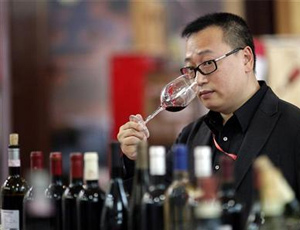China’s Exploding Wine Consumption
U.S., Chile, Australia as well as old world wines all generating increasing market shares as China develops new tastes
Op-Ed Commentary: Chris Devonshire-Ellis
 May 21 – China is a country that continues to surprise, even 20 years after I first established my business there. Back in 1992, drinking coffee was limited to the few hotels that even had such a thing as a Nescafe sachet. Last October, Starbucks opened its 500th store, not bad going for a nation once considered purely tea drinkers. The same story, that of changing consumer tastes, has filtered across many F&B markets, not least with wine. In 1992, red wine would be drunk as a highball with coke, and white wine with 7Up. While that may be understandable given the general quality of wine in China at the time, that is not the case today, and rather like the coffee phenomena, wine consumption has sky rocketed and continues to do so.
May 21 – China is a country that continues to surprise, even 20 years after I first established my business there. Back in 1992, drinking coffee was limited to the few hotels that even had such a thing as a Nescafe sachet. Last October, Starbucks opened its 500th store, not bad going for a nation once considered purely tea drinkers. The same story, that of changing consumer tastes, has filtered across many F&B markets, not least with wine. In 1992, red wine would be drunk as a highball with coke, and white wine with 7Up. While that may be understandable given the general quality of wine in China at the time, that is not the case today, and rather like the coffee phenomena, wine consumption has sky rocketed and continues to do so.
Also, it’s not just China that is developing a taste for imported wine, this is a growing trend across Asia. However, there are pointers regarding how to best accomplish this, and it may not purely be a matter of exporting and expecting consumers to be automatically knowledgeable.
Take, for example, the experience of American wine exports to Japan which are currently very healthy. Some 90 percent of U.S. wine exports originate from California and the U.S. export market was up 21.7 percent overall in 2011, reaching a total export value of US$1.39 billion according to the American Wine Institute. Of the increases across Asia, Japan showed a sudden and somewhat unexpected increase – up 39 percent year-on-year to reach US$105 million in terms of export value. For a mature market, that’s spectacular, especially as previous growth had been relatively slow. But the reason lies more to do with clever marketing and product adjustment than a sudden urge by the Japanese to consume more alcohol.
“U.S. bulk wine exports to Japan have been growing as major Japanese importers are now importing popular-priced California wine brands in bulk and bottling in Japan. This reduces the burdensome import duty to a certain extent and makes inventory control easier,” said Wine Institute Trade Director in Japan, Ken-ichi Hori. “Concerning bottled U.S. wine, Japan is now importing more expensive California wines than in the past. California wine is well represented at high-end restaurants because of our successful annual restaurant promotion.”
That bulk shipping and local bottling in Japan of Californian wine has largely been the trigger for the sizeable export increase. After all, this is something that the Chileans have known for years as they are one of the largest bulk suppliers of wine to China in a market worth some US$83 million to them last year. Chile accounts for 35 percent of the total bulk wine (containers above 2 liters) exported to China, but at the same time, bottled wine sales were worth US$35 million in 2011 and grew by 53 percent. That same market strategy has been working for them, and the price point of the better Chilean wines – especially labels like Baron Phillipe de Rothschild – have been growing as well.
As for China, Hong Kong scrapped import duty on wines three years ago and that has led to a massive boom in wine consumption and services there. Wines for the Asian market are being warehoused in Hong Kong, and top-end wine auctions held only recently in the city have been an outstanding success as Asian consumers find world class wines now available right on their doorstep for the first time. Sotheby’s set up there in 2009 and have achieved record prices for some of the best vintages. In terms of American wines, exports to Hong Kong increased 39 percent in 2011 to US$163 million. Mainland China too has been booming for American wines – exports were up 42 percent last year to China, achieving a respectable sales volume of US$62 million. Californian wines are now a familiar sight on many high-end restaurant menus throughout China, a trend that is only set to continue. Consider this – the Chinese will have the second largest number of citizens travelling overseas next year, having overtaken the Japanese, and a total of 8 percent of the outbound global tourist market, according to Boston Consulting. Much of that outbound tourism will be to Europe and the United States, and with it an introduction to Western food and wines. Meanwhile, within China, Intercontinental Hotels, the largest hotel operator in the world, will have some 6.1 million rooms in China by 2025, the same as it has today in the United States. By 2035, it will have 9.1 million hotel rooms in China – about four times the number in 2012. Hilton Hotels currently has 25 hotels in China, with that set to reach 100 by 2014. Starwood Group, which has 70 properties under management in China today, has another 90 under development. That five-star, international standard of hotel accommodation, service and yes – F&B outlets – will serve as a conduit for millions of Chinese to taste their first glasses of wine, a habit that proven Chinese wine consumption has suggested will only continue to grow and develop.
Suggestions then that the wine market in China is already the preserve of dominant French and Australian brands are way off the mark – and something that neither the U.S. wine industry or the Italians would agree with. According to the Italian Institute for Statistics, exports of Italian wine to China grew by 80 percent between 2010 and 2011.
“[The Chinese] are very interested in our wine. The orientation of consumers around the world is moving in search of high quality products. They’re looking for companies specialized in producing high quality wines,” said Giuseppe Santini, an exporter of wines to China.
The French wine industry overall increased its global exports by 10.5 percent last year, to a value of 10 billion euros. Exports to Asia rose sharply, with China jumping two spots to become the third-largest importer of French wine and spirits, according to Louis Fabrice Latour of the Federation of Wine and Spirits Exporters. France remains dominant, both in market volume and value, mainly due to the fact that well, it makes the world’s best wines, commands the best prices, and the product is utterly synonymous with the French culture in a way which other countries cannot match.
But that’s not to suggest that the French are the only game in town, because that is far from being the case. Australia recorded a 32 percent increase in wine sales to China, with the market worth A$181 million in 2011. According to Lucy Anderson, Wine Australia’s Director for China, the Chinese consumers accounted for the biggest buyers of wines priced above A$10 a liter. The Chinese consumer market is becoming more affluent and is showing signs of greater price tolerance for better quality and especially red wines. A 50 percent growth rate was recorded in wines priced between A$20-A$50,
Spain is also a major exporter of wines to China, and it too has experienced a surge in exports. According to the Spanish Wine Market Supervisory Board, exports to China increased by 56 percent in 2011 and doubled in value to 78 million euros. Spanish wines, in terms of volume, are now only second to France when exporting to China, suggesting that the market is more open for medium bodied reds of decent quality than many may suspect. That is borne out by China’s own wine importation statistics, with China Customs releasing data for 2011 that states the country’s total wine imports were up 27.7 percent in volume, and 71.7 percent in value – suggesting that the China consumer is buying more, and better quality wines.
The song remains the same for Portugal, whose own Vini Portugal states that exports to China doubled in 2011 from a year earlier. That is perhaps because, or maybe despite, Portugal’s wine varietals being unusual for many Asians, comprising a combination of medium and full-bodied wines from the Douro, in addition to sweet fortified wines such as Port and Madeira, both of which can now be found in Chinese, yet western-themed supermarkets across China such as Jenny Lous and other similar outlets.
The story continues with both South Africa, through their World of South African Wines folk reporting huge export increases (80 percent 2011 growth of bottled wines) to China, and New Zealand, with its fine Pinot Noirs and Chardonnays gaining great acceptance – the kiwis apparently recording a 180 percent increase in wine sales to China for the past year. It may also be said that Australia, New Zealand, and South Africa all have geographical advantages in terms of shipping to China and relatively young, yet dynamic production and marketing teams in place. But whichever way one massages the statistics, clearly, the global market is moving, fast, and especially in China and Asia.
Coupled with that, the point of sale is increasingly foreign-owned as well in China, an example being my good friend (the excellently named Christophe) at Cheese & Wine who has cornered a fine upmarket clientele of both savvy Chinese consumers and expats in Beijing. There are other, similar gourmets in other Chinese cities, and the trend for bespoke, fine wine outlets in China is gathering pace as local Chinese demand the same experience as they had abroad – intimacy, exclusivity and quality. That’s “the three Y’s” right there.
Growth of wine exports to China in 2011
- New Zealand: +180%
- Italy: +80%
- South Africa: +80%
- Spain: +56%
- Chile: +53%
- United States: +39%
- Australia: +32%
- France: +24.5%
(Note: Stats have come from individual national trade associations and have not been independently verified. French growth is from a higher overall market penetration. Growth figures do not necessarily represent actual volume)
The lack of statistical verification aside, these outstanding figures seem to suggest that Chinese appreciation for wine is growing and that they are prepared to spend more. Branding of course remains an issue, and one Asian-based importer of Australian wines told me: “For the new Asian consumers to this market, they are not interested in Chateau names. They seem confusing and they can’t relate to them. They just want something easily identifiable to their own culture in terms of name and presentation.”
For many overseas vineyard owners, the easiest way is to appoint a China-based distributor. However, with such a choice and everyone clamoring to get into China, even the big wine distributors such as ASC, Torres and Summergate may not be able to differentiate your product from the many others they carry, although the payoff is they have excellent national distribution networks. Perhaps agreeing with them to gain market access in China’s second-tier cities rather than clamor with everyone else for a slice of the Shanghai market may pay dividends. That said, there are smaller, specialist wine distributors now starting to open up and operate in China, and many represent only particular regions. Budding American wine exporters, for example, may contact or liaise with local commercial organizations with a foot in both the United States and China, such as the California-based Diablo Dragon. Otherwise, organizations such as the U.S. Department of Commerce may be useful for introductions to local people they may know. Most other countries also have their own wine exports or similar promotional boards that can assist.
But the list doesn’t just stop at the French, Italian, Australian or Californian wine exporters. Given the Chinese market size, massive growth and changing consumer tastes, Chinese consumers will be returning from overseas demanding more and more from their wine drinking experiences, and here the Greeks, Bulgarians, Germans, and even Canadians and Argentinians have plenty of consumers to aim at. Hell, I have had thoroughly enjoyable and well-planned wine tastings in China from wine exporters from the Lebanon, Hungary, and even Greek Retsina – the latter of which may be an acquired taste even to Europeans, but goes extremely well with sour fish sauce-based dishes.
Taste-wise, the Chinese seem to prefer smooth, medium-bodied red wines, and grapes such as Cabernet Sauvignon, Merlot and Shiraz blends have all been doing well. But bear in mind that many Chinese are somewhat intolerant of alcohol, and full-bodied wines at 15 or 16 percent are less inclined to find takers, meaning the old French standards of 12.5 percent or 13 percent volume do better. However, China is a hot country in the summer, and sales of Chardonnay, Pinot Grigio and Sauvignon Blanc are very healthy during this time. A well balanced, smooth, fruity and medium acidic wine will go well with many Chinese dishes, and that’s typically the consumer spot to aim for – although many Chinese enjoy sweet dessert wines such as Canada’s ice wines (made popular by the Chinese Vancouver, Hong Kong set), Port, and Tokaji. Not to mention Chateau Yquem and the various excellent sauternes at the top end. However today these, as is the case in Europe, are considered an end of meal digestif rather than something to serve during the meal.
The Asian wine export market doesn’t just mean China. Interestingly, U.S. wine exports to Vietnam grew by a whopping 266 percent in 2011, a combination of Vietnam’s colonial French heritage kicking in, a growing and dynamic consumer market developing, and tourism being on the increase. Global imports to Singapore – itself a regional Asian wine distribution hub – increased by some 87 percent last year. However, for wine exporters globally, Chinese consumption of wine is a long way from being a done deal in terms of competition and market access and there is still plenty of room for exporters to China to find their niche. Salut!
Chris Devonshire-Ellis is the principal of Dezan Shira & Associates and a member of the Food & Wine Committee of Beijing’s prestigious Capital Club. Dezan Shira & Associates have worked in the past with all of China’s largest wine importers, and are familiar with all aspects of the wine industry in China, including import duties, bonded warehousing issues, and distribution. The firm can assist with contractual agreements, trademark registrations, the establishment of sales/marketing outlets and related legal and tax structures. The practice can also assist with similar enquiries for markets across Asia and has 20 offices across the region, including Singapore and Vietnam. For assistance, please contact the practice at china@dezshira.com or view the firm’s website at www.dezshira.com.
Related Reading
China’s Wine Market Shows Great Potential
China Approves First Private Wine Equity Fund
Getting Money Out of China: Macau Casinos, Xinjiang Jade and French Wines?
Consumption Trends and Targeting China’s Female Consumers
Report: China’s 2020 Consumer Demographics
- Previous Article Severance Pay Subject to Individual Income Tax in China
- Next Article Why ASEAN Matters For Your China Business



























